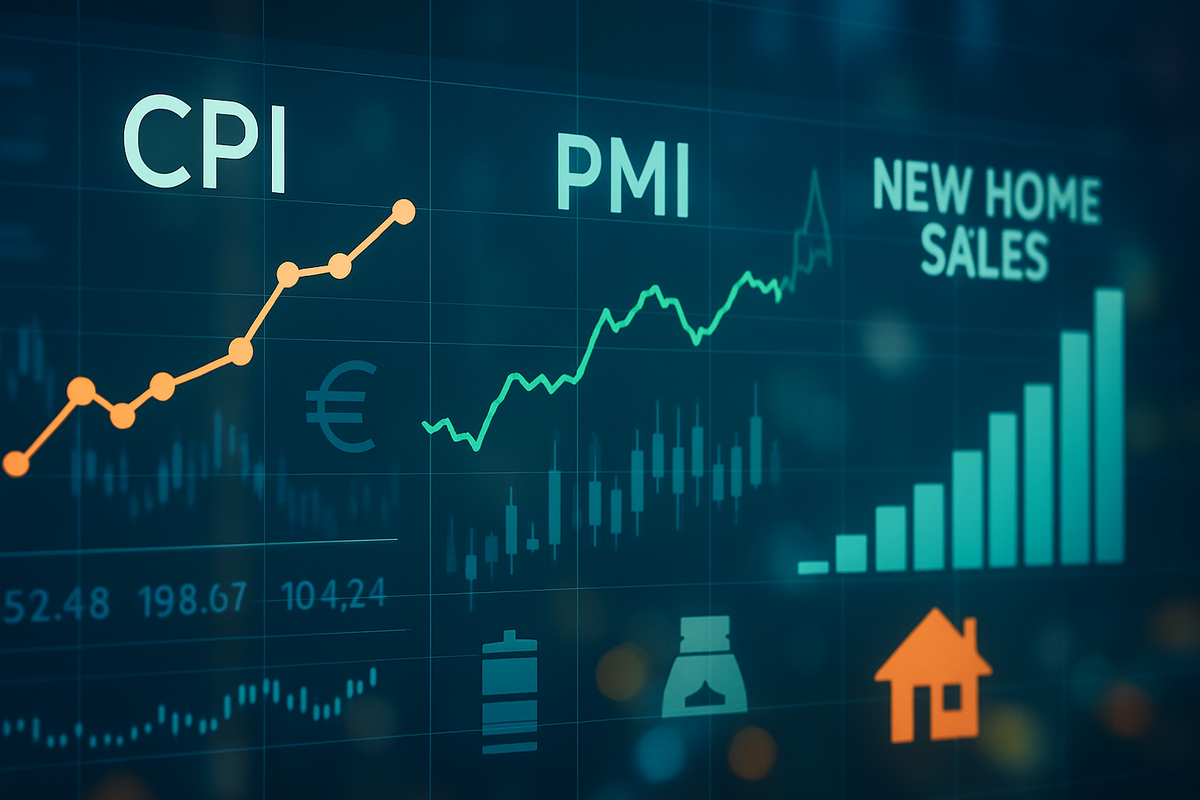
Financial markets are bracing for a pivotal "Economic Friday" on October 24, 2025, as a trio of crucial data releases – the Consumer Price Index (CPI), Purchasing Managers' Index (PMI), and New Home Sales – are poised to offer a comprehensive snapshot of the U.S. economy. These indicators, scheduled for release throughout the day, hold significant sway over investor sentiment, commodity prices, and the future trajectory of the Federal Reserve's monetary policy, potentially triggering substantial market volatility. Traders, analysts, and policymakers will be scrutinizing every decimal point for clues on inflation, economic growth, and the health of the housing sector.
The confluence of these high-impact reports comes at a delicate time for the global economy, where persistent inflation concerns battle against signs of moderating growth. The Federal Reserve has maintained a data-dependent stance, making each economic release a critical determinant of future interest rate decisions. A deviation from consensus forecasts in any of these reports could either solidify expectations for a stable monetary policy or reignite debates about further tightening or potential easing, directly impacting borrowing costs for businesses and consumers alike.
A Deep Dive into Friday's Market Movers
Friday, October 24, 2025, will be a marathon for market participants, beginning with the September 2025 Consumer Price Index (CPI) at 8:30 A.M. Eastern Time, released by the U.S. Bureau of Labor Statistics (BLS). Economists are forecasting a slight uptick in headline inflation, with expectations for the annual rate to rise to 3.0% from 2.9% in August, while core CPI, which strips out volatile food and energy prices, is anticipated to hover around 3.0%, a marginal decrease from August's 3.1%. Following this, at 10:00 a.m. ET, the U.S. Census Bureau and the Department of Housing and Urban Development will jointly release New Residential Sales for September 2025, providing vital insights into the housing market's momentum. Later in the day, at 13:45 GMT (9:45 A.M. ET), the S&P Global Flash US Manufacturing PMI will be published, with consensus forecasts pointing to an improvement to 52.6 from 51.9, signaling continued expansion in the manufacturing sector.
These releases are not isolated events but rather the latest chapters in an ongoing economic narrative. The Federal Reserve has been navigating a complex landscape, balancing its dual mandate of maximum employment and price stability. Lingering supply chain issues, geopolitical tensions, and fluctuating energy prices have contributed to an elevated inflationary environment over the past couple of years. The housing market, highly sensitive to interest rates, has experienced periods of both boom and slowdown, directly reflecting the Fed's tightening cycle. Manufacturing, meanwhile, has shown resilience, but faces headwinds from global demand shifts and input cost pressures. Key players include the data-gathering agencies (BLS, S&P Global, Census Bureau), the Federal Reserve as the primary policymaker, and, of course, millions of investors, businesses, and consumers whose decisions are influenced by these figures. Initial market reactions are often swift and dramatic: stronger-than-expected inflation could trigger a sell-off in equities and a rally in the U.S. dollar, while robust PMI data might boost industrial stocks and commodity prices.
Corporate Winners and Losers in the Economic Crosscurrents
The outcomes of Friday's data deluge will inevitably create winners and losers across various sectors and public companies. A higher-than-expected CPI figure, signaling persistent inflation, would likely put pressure on consumer discretionary companies (e.g., Amazon.com Inc. (NASDAQ: AMZN), Target Corporation (NYSE: TGT)) as consumers face eroded purchasing power. Companies with high input costs, particularly those in manufacturing or transportation, could also see profit margins squeezed. Conversely, sectors that tend to perform well in inflationary environments, such as energy (e.g., Exxon Mobil Corporation (NYSE: XOM)) and materials (e.g., Freeport-McMoRan Inc. (NYSE: FCX)), could see an uplift in commodity prices. Financial institutions (e.g., JPMorgan Chase & Co. (NYSE: JPM)) might benefit from higher interest rates if the Fed is prompted to tighten further, improving net interest margins.
A strong PMI reading, indicating robust manufacturing activity, would be a boon for industrial companies (e.g., General Electric Company (NYSE: GE)), technology firms supplying factory automation (e.g., Rockwell Automation, Inc. (NYSE: ROK)), and logistics providers (e.g., United Parcel Service, Inc. (NYSE: UPS)). Increased manufacturing output typically translates to higher demand for raw materials, benefiting commodity producers. Conversely, a weak PMI could signal a slowdown, hurting these same sectors and potentially leading to a flight to defensive stocks. The New Home Sales data directly impacts homebuilders (e.g., D.R. Horton, Inc. (NYSE: DHI), Lennar Corporation (NYSE: LEN)), building material suppliers (e.g., Louisiana-Pacific Corporation (NYSE: LPX)), and home improvement retailers (e.g., The Home Depot, Inc. (NYSE: HD)). Strong sales, especially if accompanied by easing mortgage rates, could boost these companies, while a significant slowdown could lead to inventory gluts and price reductions, impacting their profitability. Mortgage lenders and banks with significant exposure to the housing market would also be closely watching this report.
Broader Economic Significance and Ripple Effects
These economic releases are more than just numbers; they are critical components in the broader narrative of the U.S. and global economies. The CPI is the linchpin of the inflation fight, directly influencing the Federal Reserve's monetary policy. A sustained period of inflation above the Fed's 2% target would necessitate continued hawkishness, potentially leading to higher interest rates and a stronger U.S. dollar, which can make U.S. exports more expensive and impact multinational corporations. Conversely, a significant deceleration in inflation could open the door for future rate cuts, easing financial conditions and stimulating growth. The PMI offers a forward-looking perspective on economic health, providing an early indication of business sentiment, order books, and employment trends. Strong PMI readings suggest resilience and potentially higher corporate earnings, while weak readings can signal an impending slowdown or recession, impacting global supply chains and trade partners.
The New Home Sales data reflects the health of the consumer and the sensitivity of the economy to interest rates. A robust housing market typically indicates strong consumer confidence and a wealth effect that can spur broader spending. However, persistently high home prices and mortgage rates, even with modest sales growth, highlight ongoing affordability challenges, which could have long-term societal and economic implications. Historically, the housing market has often been a leading indicator for broader economic cycles. For instance, a significant downturn in housing can precede a recession, as seen in the 2008 financial crisis. Regulatory bodies and policymakers will be closely watching these figures to assess the effectiveness of current policies and consider potential adjustments, such as housing stimulus programs or targeted inflation-fighting measures. The ripple effects extend to international markets, as a strong or weak U.S. economy impacts global demand, trade balances, and currency valuations.
What Comes Next: Navigating the Economic Crossroads
The immediate aftermath of Friday's data releases will likely see increased market volatility as investors digest the information and adjust their portfolios. In the short term, a "hot" CPI print combined with strong PMI could lead to expectations of continued monetary tightening, pushing bond yields higher and potentially causing a temporary dip in equity markets, especially growth stocks. Conversely, softer-than-expected inflation coupled with a cooling manufacturing sector could foster hopes of a sooner-than-anticipated rate cut, boosting risk assets. The housing data will provide critical context for consumer resilience and the impact of existing monetary policy.
Longer-term, the cumulative picture painted by these indicators will heavily influence the Federal Reserve's next steps. If inflation proves sticky, the Fed might be compelled to maintain higher rates for longer, posing a challenge for highly leveraged companies and potentially slowing economic growth. If inflation moderates convincingly, and growth indicators like PMI show stability, the path to a more accommodative monetary policy becomes clearer, potentially unlocking new market opportunities in interest-rate sensitive sectors. Companies will need to remain agile, with potential strategic pivots focusing on cost management in an inflationary environment, supply chain optimization amidst manufacturing shifts, and adapting to evolving consumer demand in the housing sector. Investors will be looking for opportunities in sectors poised to benefit from specific outcomes – for instance, value stocks in a higher-rate environment or growth stocks if rate cuts become more probable.
Comprehensive Wrap-up: A Critical Juncture for Markets
Friday's economic data releases represent a critical juncture for financial markets, offering indispensable insights into the U.S. economy's health. The CPI will be the ultimate arbiter of the ongoing inflation debate, shaping expectations for the Federal Reserve's interest rate policy. The PMI will provide a real-time pulse on the manufacturing sector, a bellwether for broader economic activity, while New Home Sales will highlight the resilience of the consumer and the housing market under current economic conditions.
Moving forward, the market's trajectory will be largely dictated by how these indicators collectively influence the Fed's decision-making process. A scenario where inflation remains elevated but economic growth falters (stagflationary fears) would present the most significant challenge, potentially leading to a prolonged period of uncertainty. Conversely, a "goldilocks" scenario of moderating inflation alongside stable growth would likely be met with market enthusiasm. Investors should remain vigilant, closely monitoring not only the headline figures but also the underlying components of each report, such as core CPI, new orders in PMI, and regional housing trends. The coming months will reveal whether the economy is successfully navigating its path to price stability and sustainable growth, or if further adjustments will be required from policymakers and market participants alike.
This content is intended for informational purposes only and is not financial advice








